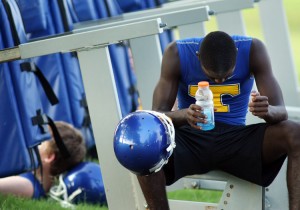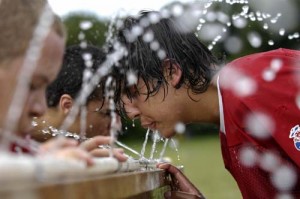
Here is a concern for all of us: Heat illness is the third leading cause of death among high school athletes in the U.S. In the vast majority of cases, heat illness is preventable with little more than common-sense precautions. And when it does occur, early detection and proper management can minimize if not eliminate the mortality risk. In our community, the team physicians at Mid State Orthopaedic & Sports Medicine work directly with our schools and coaches to educate them on prevention of heat illness. Having a Certified Athletic Trainer on site for advising, monitoring and treating athletes should be a mandatory requirement.
.
“Heat illness” consists of four most commonly recognized categories:
Heat Cramps
Exercise-associated muscle cramps are a common result of working out in hot weather, particularly when accompanied by profuse and prolonged sweating. It is characterized by acute, painful involuntary skeletal muscle twitching and spasms, usually affecting the arms, legs, and abdomen.
Heat Syncope
This condition presents as a syncopal episode (fainting) or lightheadedness during exposure to hot temperatures. Predisposing factors include exercising without a cool-down period and being in a dehydrated state during physical activity.

By definition, this is a physical inability to continue exercise in the heat, and it is associated with heavy sweating, dehydration, sodium loss, and energy depletion. Symptoms include profuse sweating, fatigue, general malaise, nausea, vomiting, headache, hyperventilation, an elevated heart rate (tachycardia), hypotension, vertigo, anxiety, and confusion.
Exertional Heat Stroke
This most extreme form of heat illness is characterized by a core temperature of greater than 104.9 degrees Fahrenheit accompanied by signs of organ system failure. It is life-threatening and should be considered an immediate medical emergency. The signs of exertional heat stroke include tachycardia, hypotension, sweating (although the skin may also be dry at the time of collapse), hyperventilation, altered mental status, irritability, lack of muscle control (ataxia), vomiting, seizures, and coma.
There are several preventative measures that can be taken that can help reduce the risk of heat-related illness:
Acclimatization
Even light or moderate exercise that’s easy to perform in cool conditions can become extremely difficult during an athlete’s first exposure to hot weather in a long while. However, repeated exposure to a hot environment produces physiological changes that improve work capacity and heat regulation. This acclimatization process is one of the most critical concepts to understand in order to keep athletes safe in the heat. Over time, the same amount of work in hot weather becomes less physically stressful, and an athlete can work harder and longer without an increased health risk.

While acclimatization may be the most important longer-term guard against heat illness, hydration is the critical short-term consideration. Acclimatized or not, athletes who aren’t properly hydrating are at much greater risk for serious health problems than athletes who are. Dehydration occurs any time an athlete loses more fluid than they replenish through drinking. It can occur acutely within a workout, or cumulatively over the course of multiple days. Sweat is the body’s primary means of cooling during exercise, and without an adequate volume of fluid to perspire, heat regulation is severely hampered.
Prehydration: The best available evidence suggests athletes should ingest at least 16 to 20 fluid ounces of water or a sports drink two hours prior to physical activity to promote good hydration status and “kick start” the body’s absorption mechanisms. In particularly hot conditions, they should drink another 10 to 20 fluid ounces 30 to 60 minutes before exercise
Hydration: During exercise and activity athletes should be consuming water and not soft drinks or sports drinks. A good starting point is to aim for at least eight ounces of fluid intake every 20 minutes during activity.
Rehydration: After exercise, post-workout weight should determine how much the athlete must drink to rehydrate. Any time they’ve lost weight due to a workout, they should drink enough fluid to return to pre-activity weight. Sports drinks are a better option than water for rehydration, as they replenish sodium and other electrolytes lost through sweat, along with carbohydrates and other ingredients that help replace glycogen stores.
Conditioning Level
Not surprisingly, one more key physical factor in heat stress risk is conditioning level. Those who are out of shape are less able to internally regulate body temperature. They also typically lose more sodium through sweat than athletes who are better conditioned.
Heat illness has received much attention in the sports medicine community in recent years, so today’s coaches and athletic trainers are more educated on the topic than ever before. Here are a few other points of advice on minimizing risk.
Watch The Weather
Environmental factors that affect exertional heat illness risk include ambient air temperature, relative humidity, air motion, and the amount of radiant heat from the sun. Scheduling the majority of practices early and late in the day can help.
Talk About Supplements
For better or worse, athletes often seek to boost their performance, energy level, or muscle growth with over-the-counter dietary and nutritional supplements. Many of these products are harmless if used properly, but some carry significant health risks, particularly for athletes exercising in the heat.
Change Clothes
Clothing creates a barrier to evaporation, impairing the body’s ability to dissipate heat. Athletes who wear apparel and equipment that doesn’t allow for heat dissipation are obviously at increased risk for exertional heat illness.
Encourage Vigilance
Every athlete should know the symptoms of heat illness and be instructed to report to an athletic trainer when they see someone who may be struggling. Some of the more subtle signs, such as confusion or altered mental state, will most likely be noticed by teammates before anyone else. In addition, all parents and coaches should be educated on heat illness symptoms, so that problems can be identified as soon as possible in any workout setting.
As long as athletes and hot weather coexist, the dangers of heat illness cannot be ignored. With a proactive approach rooted in prevention, education, and preparedness, you can rest assured that your athletes are as safe as possible.









